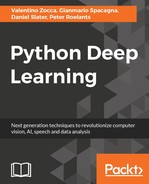The last chapter focused on solving board games. In this chapter, we will look at the more complex problem of training AI to play computer games. Unlike with board games, the rules of the game are not known ahead of time. The AI cannot tell what will happen if it takes an action. It can't simulate a range of button presses and their effect on the state of the game to see which receive the best scores. It must instead learn the rules and constraints of the game purely from watching, playing, and experimenting.
In this chapter, we will cover the following topics:
- Q-learning
- Experience replay
- Actor-critic
- Model-based approaches
The challenge in reinforcement learning is working out a good target for our network. We saw one approach to this in the last chapter, policy gradients. If we can ever turn a reinforcement learning task into a supervised task problem, it becomes a lot easier. So, if our aim is to build an AI agent that plays computer games, one thing we might try is to look at how humans play and get our agent to learn from them. We can make a recording of an expert human player playing a game, keeping track of both the screen image and the buttons the player is pressing.
As we saw in the chapter on computer vision, deep neural networks can identify patterns from images, so we can train a network that has the screen as input and the buttons the human pressed in each frame as the targets. This is similar to how AlphaGo was pretrained in the last chapter. This was tried on a range of complex 3D games, such as Super Smash Bros and Mario Tennis. Convolutional networks were used for their image recognition qualities, and LTSMs were used to handle the long-term dependencies between frames. Using this approach, a trained network for Super Smash Bros could defeat the in-game AI on the hardest difficulty setting:

Learning from humans is a good starting point, but our aim in doing reinforcement learning should be to achieve super-human performance. Also, agents trained in this way will always be limited in what they can do, and what we really want are agents that can truly learn for themselves. In the rest of this chapter, we'll look at approaches that aim to go further than replicating human levels.
